The Ultimate Guide to Finding the Best Wrist Brace for Carpal Tunnel Syndrome

Carpal Tunnel Syndrome (CTS) is a prevalent and often debilitating condition that affects millions of people worldwide. It occurs when the median nerve, which runs from the forearm into the palm of the hand, becomes compressed or squeezed at the wrist. This compression can result in a range of distressing symptoms, including pain, numbness, tingling, and weakness in the hand and wrist. If left untreated, CTS can significantly impact one’s quality of life, making even simple tasks like typing, gripping objects, or holding a book painful and difficult.
In seeking relief from the discomfort caused by CTS, wrist braces have emerged as invaluable tools. These braces are designed to support the wrist, alleviate pressure on the median nerve, and promote proper hand and wrist alignment. They have become essential aids in managing CTS, allowing individuals to regain control over their lives and daily activities.
This comprehensive guide aims to be your go-to resource for understanding Carpal Tunnel Syndrome and finding the best wrist brace to manage it effectively. We understand the challenges that come with this condition, and we’re committed to helping you navigate the world of wrist braces with confidence.
In the following sections, we will delve into the intricate details of Carpal Tunnel Syndrome, explore the different types of wrist braces available, and provide expert guidance on choosing the right one for your unique needs. We’ll also share real-life success stories, tips for proper brace usage, and other management strategies that can complement the use of wrist braces. By the end of this guide, you’ll be equipped with the knowledge and insights needed to take proactive steps toward managing your Carpal Tunnel Syndrome and regaining your comfort and mobility. Let’s embark on this journey together and discover the ultimate solutions for your wrist-related woes.
Understanding Carpal Tunnel Syndrome
Carpal Tunnel Syndrome (CTS) is a widespread and often misunderstood medical condition that can have a profound impact on your daily life. At its core, CTS is a nerve disorder that primarily affects the wrist and hand. The condition gets its name from the carpal tunnel, a narrow passageway located on the palm side of your wrist. This tunnel is home to the median nerve, one of the major nerves responsible for controlling sensation and movement in the hand.
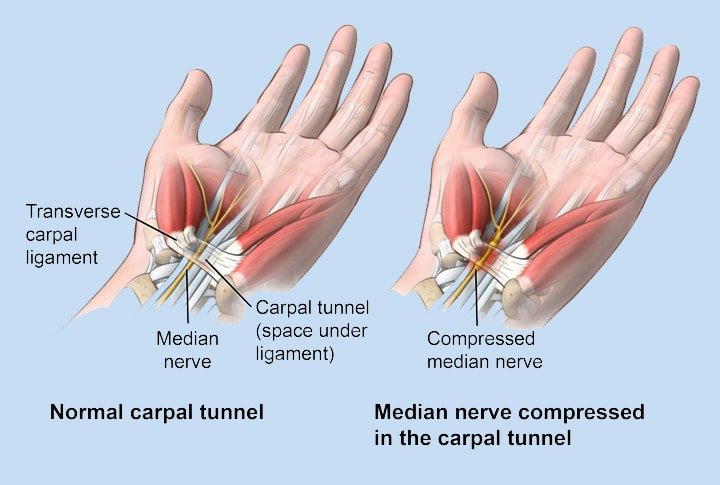
What Causes CTS?
Understanding the causes and risk factors of CTS is essential in managing and preventing it. CTS typically develops when the median nerve is compressed or irritated within the carpal tunnel. Several factors can contribute to this compression, including:
- Repetitive Hand Movements: Jobs or hobbies that involve repetitive hand and wrist movements, such as typing, assembly line work, or playing musical instruments, can increase the risk of CTS.
- Anatomy: Some individuals may have a narrower carpal tunnel naturally, leaving less room for the median nerve, making them more susceptible to CTS.
- Health Conditions: Certain medical conditions, such as diabetes, rheumatoid arthritis, and thyroid disorders, can increase the likelihood of developing CTS.
- Pregnancy: Hormonal changes and fluid retention during pregnancy can put pressure on the median nerve, leading to temporary CTS symptoms.
Recognizing the Symptoms
CTS often manifests with a range of uncomfortable and sometimes painful symptoms. Common signs and symptoms of CTS include:
- Numbness and Tingling: You may experience numbness, tingling, or a “pins and needles” sensation in the thumb, index, middle, or ring fingers.
- Weakness: Weakness in the hand and a tendency to drop objects can occur as CTS progresses.
- Pain: Pain that radiates from the wrist and travels up the arm can be a hallmark symptom of CTS.
- Nighttime Symptoms: Many people with CTS report that their symptoms are more pronounced at night, often waking them from sleep.
The Importance of Early Diagnosis and Treatment
Early diagnosis and treatment are crucial in effectively managing and preventing CTS from worsening. If left untreated, CTS can lead to permanent nerve damage and a significant decline in hand function. Timely intervention can often alleviate symptoms and improve your overall quality of life. In the following sections, we will explore the various treatment options available, including the essential role that wrist braces play in relieving CTS-related discomfort.

Types of Wrist Braces
When it comes to managing Carpal Tunnel Syndrome (CTS), wrist braces are invaluable tools. They provide essential support, alleviate pressure on the median nerve, and promote proper hand and wrist alignment. However, not all wrist braces are created equal, and choosing the right one can significantly impact your comfort and recovery. In this section, we’ll take a closer look at the different types of wrist braces available, delve into their pros and cons, and provide guidance on selecting the ideal one based on your individual needs.
1. Carpal Tunnel Splints:
Overview: Carpal tunnel splints, also known as rigid wrist braces, are designed to immobilize the wrist and keep it in a neutral position. They often cover the wrist and part of the forearm, offering maximum support.
Pros:
- Excellent support for severe CTS cases.
- Effective at reducing wrist movement, which can alleviate pain and discomfort.
- Ideal for nighttime use when symptoms are typically more pronounced.
Cons:
- Limited hand and finger mobility when worn.
- Bulky and may not be suitable for all activities.
- Considerations: Carpal tunnel splints are typically recommended for individuals with severe CTS or those who need additional support during the night.
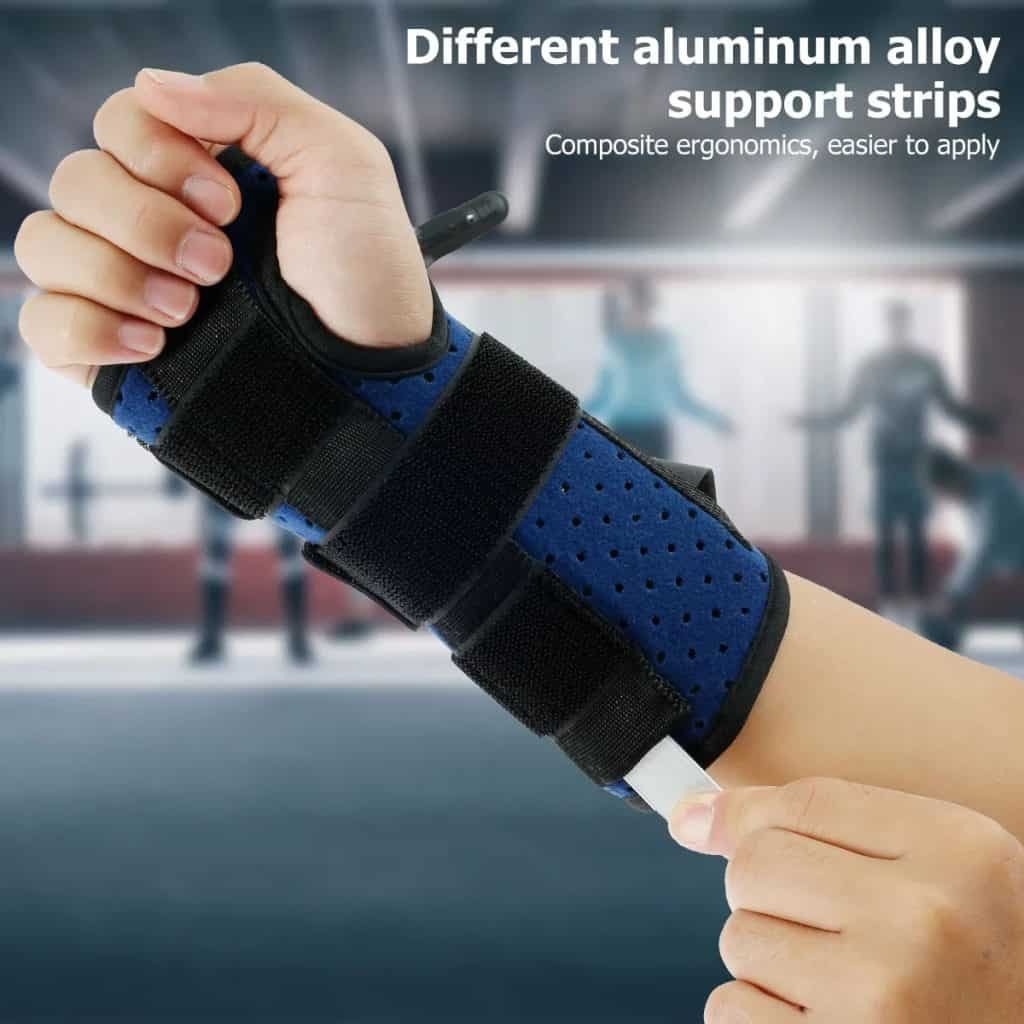
2. Wrist Braces with Splints:
These braces combine the support of a splint with the flexibility of a traditional brace. They offer support along the wrist’s underside while allowing some degree of hand and finger movement.
Pros:
- Balances support and mobility.
- Suitable for both day and nighttime use.
- Provides relief while allowing for limited hand function.
Cons:
- May not offer as much support as rigid splints for severe cases.
- Considerations: Wrist braces with splints are versatile and can be a great option for individuals with moderate CTS, providing support without sacrificing all hand movement.
3. Compression Wrist Sleeves:
Overview: Compression wrist sleeve is a lightweight, elastic sleeves that provide gentle compression to the wrist area. They are less restrictive than splints and braces.
Pros:
- Comfortable and discreet for all-day wear.
- Ideal for mild to moderate CTS cases.
- Easy to put on and take off.
Cons:
- Less rigid support compared to splints or braces.
- May not be sufficient for severe CTS.
- Considerations: Compression wrist sleeves are perfect for those with mild to moderate CTS or individuals who require wrist support during everyday activities.
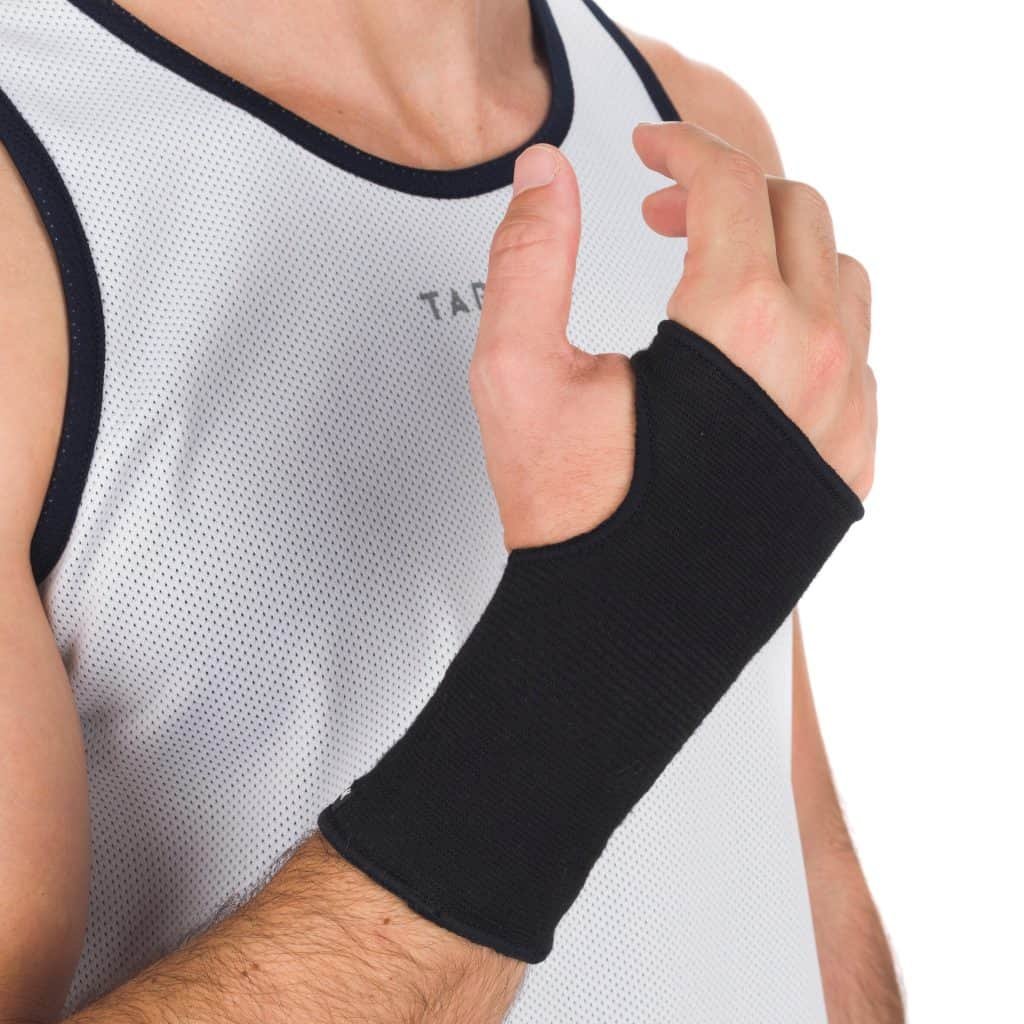
When choosing the best Wrist Brace for Carpal Tunnel Syndrome, consider the severity of your condition, your daily activities, and your personal comfort preferences. Consulting with a healthcare professional can help you make an informed decision that will best suit your individual needs. Remember, the right wrist brace can be a game-changer in managing your CTS and improving your overall quality of life.
Benefits of Using a Wrist Brace
How does a wrist brace help carpal tunnel syndrome?
Carpal Tunnel Syndrome (CTS) can be an unwelcome companion in your life, causing discomfort, pain, and a disruption to your daily activities. Fortunately, wrist braces offer a ray of hope for individuals dealing with this condition. In this section, we’ll explore the myriad benefits of using a wrist brace, from symptom relief to an improved quality of life.
1. Alleviating Carpal Tunnel Symptoms:
Wrist braces are frontline warriors against the discomfort caused by CTS. They work by maintaining the wrist in a neutral position, reducing the pressure on the median nerve. This, in turn, alleviates symptoms such as numbness, tingling, and pain. By wearing a wrist brace, you can experience relief from these distressing sensations, allowing you to regain control over your daily life.
2. Preventing Further Damage and Complications:
CTS is a progressive condition, and if left untreated, it can lead to more severe symptoms and complications. The median nerve can sustain lasting damage, resulting in permanent loss of sensation and muscle function in the hand. Wrist braces act as a barrier, preventing the condition from worsening. They help maintain proper wrist alignment, reducing the risk of long-term nerve damage.
3. Enhancing Wrist Support and Stability:
Wrist braces are engineered to provide essential support to the wrist joint. They help stabilize the wrist, minimizing excessive movement that can exacerbate CTS symptoms. This added stability is particularly beneficial during activities that require repetitive hand and wrist motions, such as typing, using tools, or playing musical instruments. With enhanced support, you can engage in these activities with more confidence and less discomfort.
4. Improved Quality of Life:
Perhaps the most significant benefit of using a wrist brace is the potential for an improved quality of life. By alleviating symptoms and preventing further damage, these braces empower you to maintain your independence and engage in activities you love. Whether it’s pursuing your career, enjoying hobbies, or simply performing everyday tasks with ease, a wrist brace can be a transformative tool on your journey to a better quality of life.
In summary, wrist braces are not just devices; they are lifelines for those battling Carpal Tunnel Syndrome. They offer relief from discomfort, act as guardians against further damage, provide stability, and ultimately enhance your overall well-being. When used in conjunction with other management strategies, wrist braces can be instrumental in helping you regain control and find comfort in your daily life.
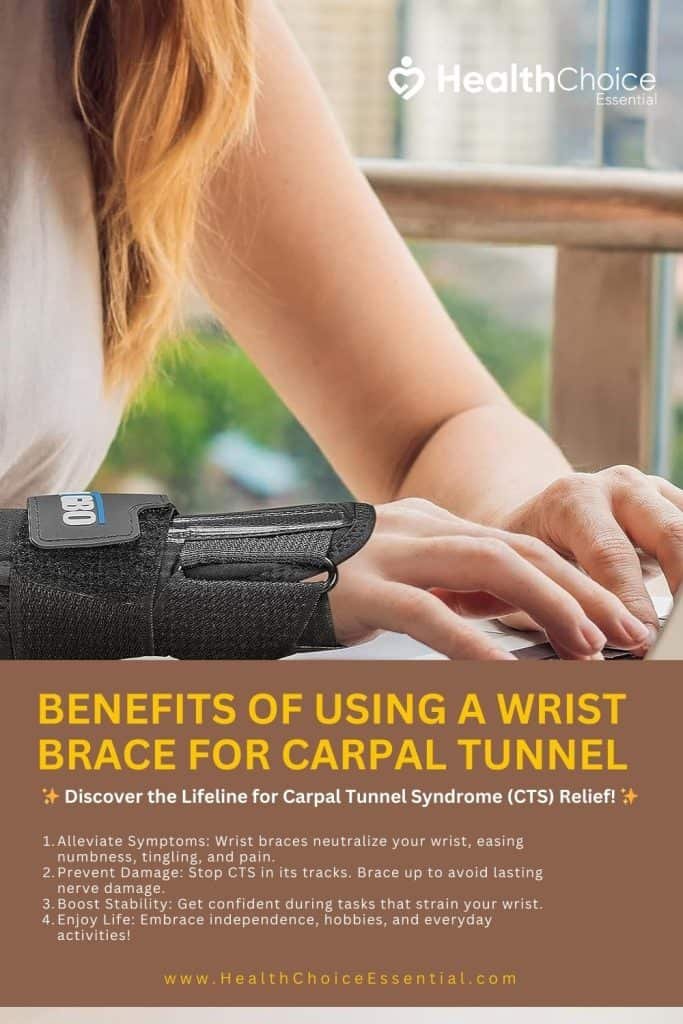
How does a wrist brace help carpal tunnel syndrome download PDF Here
How to Choose the Right Wrist Brace?
Selecting the perfect wrist brace is a crucial step in managing Carpal Tunnel Syndrome (CTS) effectively. With numerous options available, making an informed choice can greatly impact your comfort and recovery. In this section, we’ll explore the key factors to consider when choosing a wrist brace tailored to your individual needs.
1. Size and Fit:
One size does not fit all when it comes to wrist braces. Ensuring the brace fits properly is paramount. A brace that’s too tight can cause discomfort, while one that’s too loose may not provide adequate support. Measure your wrist accurately and refer to the manufacturer’s sizing guide to find the right fit. It’s worth trying the brace on and assessing its comfort before making your final decision.
2. Material and Design:
Wrist braces come in a variety of materials, each with its advantages. Neoprene braces are comfortable and offer excellent support, while breathable fabric braces are ideal for extended wear. Consider the materials’ breathability, durability, and any potential allergies or sensitivities you may have. The design should also align with your lifestyle and preferences, whether you prefer an open or closed design.
3. Support Level:
The level of support your wrist brace provides should align with the severity of your CTS. For mild cases, a compression sleeve may suffice, while severe cases may require a rigid splint. Consult with a healthcare professional to determine the appropriate level of support for your specific condition.
4. Ease of Use and Adjustability:
Convenience is key when choosing a wrist brace. Opt for a brace that’s easy to put on and take off, especially if you’ll be wearing it frequently. Additionally, look for adjustability features, such as straps or Velcro closures, that allow you to customize the fit and support as needed throughout the day.
5. Consulting a Healthcare Professional:
Above all, it’s advisable to seek guidance from a healthcare professional, such as an orthopedic specialist or physical therapist, when selecting a wrist brace. They can assess the severity of your CTS, recommend the appropriate type of brace, and provide personalized advice. Their expertise ensures that your choice aligns with your specific needs and maximizes its effectiveness.
In conclusion, choosing the right wrist brace is a pivotal decision in your journey to managing CTS. By considering factors like size, material, support level, ease of use, and consulting with a healthcare expert, you can confidently select a wrist brace that complements your unique requirements. Remember that the right brace can be a game-changer, providing the support and relief needed to enhance your quality of life.

Download PDF How to Choose the Right Wrist Brace for Carpal Tunnel and Tendonitis?
Top Features to Look for in a Wrist Brace
Choosing the perfect wrist brace for carpal tunnel is not just about finding one that fits; it’s also about understanding the key features that make a brace effective in managing Carpal Tunnel Syndrome (CTS). In this section, we’ll shine a spotlight on the top features to look for when selecting a wrist brace tailored to your unique needs.
1. Ergonomic Design:
An ergonomic design is at the heart of an effective wrist brace. Look for a brace that contours to the natural shape of your wrist and hand. This ensures a snug fit and maximum comfort, allowing you to wear it for extended periods without irritation or discomfort. An ergonomic design also promotes proper wrist alignment, a fundamental aspect of CTS management.
2. Breathability:
Comfort and breathability go hand in hand, especially if you plan to wear your wrist brace throughout the day. Opt for a brace made from breathable materials, such as neoprene or breathable fabric. These materials wick away moisture and allow air circulation, reducing the risk of sweat buildup and skin irritation.
3. Durability:
A wrist brace should be a long-term companion in your journey to manage CTS. Choose a brace that’s built to last, even with daily wear. Reinforced stitching, high-quality materials, and durable closures, like Velcro, are indicators of a long-lasting brace. Investing in durability ensures your brace continues to provide effective support over time.
4. Ease of Cleaning:
Proper hygiene is crucial when wearing a wrist brace regularly. Look for a brace that is easy to clean and maintain. Removable and machine-washable components or materials that can be wiped clean make the cleaning process hassle-free. This feature not only prolongs the life of your brace but also ensures a fresh and comfortable experience.
5. Price Range:
While the effectiveness of a wrist brace is essential, it’s also important to consider your budget. Wrist braces come in a range of price points. Assess your needs and budget carefully to find a brace that strikes the right balance between affordability and functionality. Keep in mind that a well-designed, durable brace is a worthwhile investment in your CTS management.
In conclusion, understanding the key features that make a wrist brace effective is pivotal in your journey to finding the perfect fit. Look for ergonomic design, breathability, durability, ease of cleaning, and consider your price range. By prioritizing these features, you can confidently select a wrist brace that not only provides the necessary support for CTS management but also enhances your overall comfort and quality of life.
Reviews of Popular Wrist Braces
Unveiling the Best Wrist Braces for Your Carpal Tunnel Relief
Navigating the world of wrist braces can be overwhelming, with a multitude of options available on the market. To simplify your decision-making process, we’ve conducted in-depth reviews of some of the top wrist braces, incorporating user experiences and feedback. Let’s explore and compare these options to help you find the best Wrist Brace for Carpal Tunnel Syndrome (CTS) needs.
1. Mueller Green Fitted Wrist Brace:
User Experience: Users praise the Mueller Green Fitted Wrist Brace for its exceptional support and comfort. It features adjustable straps and a lightweight design, making it suitable for both day and nighttime wear.
Pros:
- Provides excellent support.
- Breathable fabric keeps your wrist cool.
- Affordable price point.
Cons:
- May not fit larger wrists comfortably.
2. Futuro Night Wrist Sleep Support:
User Experience: The Futuro Night Wrist Sleep Support has garnered acclaim for its effectiveness during nighttime use. Users report a significant reduction in nighttime CTS symptoms, including numbness and pain.
Pros:
- Specifically designed for nighttime wear.
- Soft and comfortable material.
- Wrist brace with adjustable straps for a personalized fit.
Cons:
- May not provide adequate support for daytime activities.
3. AidBrace Wrist Support Brace:
User Experience: Users appreciate the AidBrace Wrist Support Brace‘s versatility, offering both stability and mobility. It’s suitable for various activities, from typing to weightlifting.
Pros:
- Balanced support for different CTS severity levels.
- Durable construction.
- Adjustable compression.
Cons:
- Slightly higher price point.
4. Neo G Medical Grade VCS Wrist Support:
User Experience: The Neo G Wrist Support stands out for its medical-grade quality and effectiveness. Users praise its durability and ability to alleviate CTS symptoms during daily activities.
Pros:
- Medical-grade support.
- Ergonomic design.
- Provides consistent compression.
Cons:
- Pricier compared to some other options.
5. Bracoo Breathable Wrist Brace:
User Experience: Users find the Bracoo Breathable Wrist Brace to be a comfortable and budget-friendly option. It’s ideal for mild to moderate CTS and provides essential support.
Pros:
- Affordable price.
- Lightweight and breathable.
- Adjustable straps for a secure fit.
Cons:
- May not offer sufficient support for severe CTS cases.
In summary, choosing the right wrist brace depends on your specific needs and preferences. These reviews provide a glimpse into some of the top wrist braces available, but it’s essential to consider your CTS severity, the activities you engage in, and your budget when making your decision. Consulting with a healthcare professional can also offer valuable guidance in selecting the perfect wrist brace to enhance your CTS management.
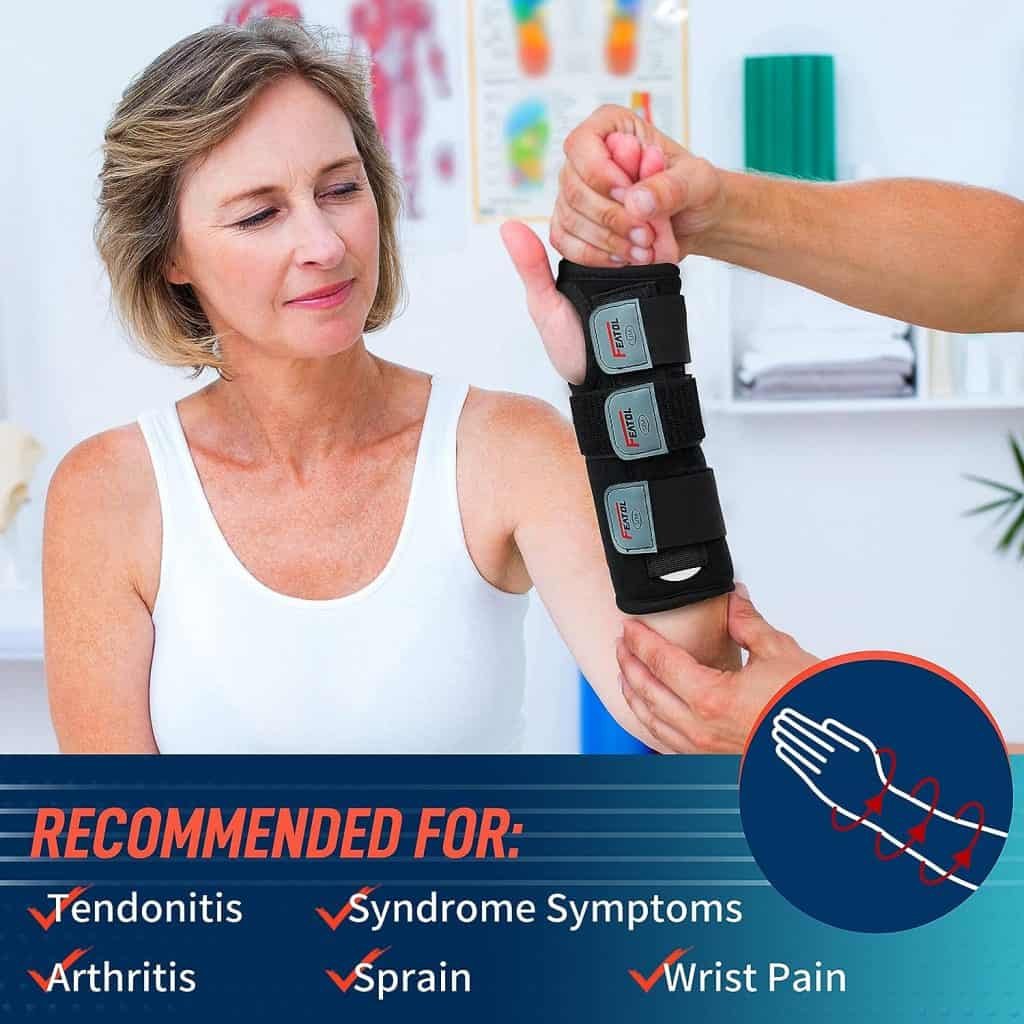
Caring for Your Wrist Brace
Your wrist brace is a valuable companion in managing Carpal Tunnel Syndrome (CTS), but like any tool, it requires proper care and maintenance to ensure its longevity and effectiveness. In this section, we’ll delve into essential tips for cleaning and maintaining your wrist brace and provide guidance on when it’s time to replace a worn-out brace.
1. Proper Cleaning and Maintenance Tips:
To keep your wrist brace in optimal condition, regular cleaning and maintenance are paramount. Here are some tips to follow:
- Read the Manufacturer’s Instructions: Always start by reading the manufacturer’s care instructions specific to your wrist brace. These guidelines will offer valuable insights into the recommended cleaning methods and frequency.
- Hand Wash or Machine Wash: Most wrist braces can be either hand-washed or machine-washed, depending on the material. Use a mild detergent and cold water for cleaning. Avoid using bleach or harsh chemicals, as they can damage the fabric and straps.
- Allow Proper Drying: After washing, allow your wrist brace to air dry completely. Avoid using high heat, as it may affect the brace’s integrity. Hanging it in a well-ventilated area is ideal.
- Inspect for Damage: Regularly inspect your wrist brace for any signs of wear and tear, such as fraying straps or weakened material. Address any issues promptly to prevent further damage.
2. Extending the Lifespan of Your Wrist Brace:
To ensure your wrist brace continues to provide adequate support, follow these tips to extend its lifespan:
- Rotate Usage: If possible, consider having multiple wrist braces and rotate their usage. This helps reduce wear on a single brace and extends their collective lifespan.
- Proper Storage: When not in use, store your wrist brace in a clean, dry place. Avoid leaving it in direct sunlight or extreme heat, which can weaken the materials over time.
- Regular Cleaning: As mentioned earlier, regular cleaning is essential not only for hygiene but also to prevent odors and material breakdown.
- Follow Instructions: Always adhere to the care instructions provided by the manufacturer. Using the correct cleaning and maintenance methods specific to your brace type will contribute to its longevity.
3. When to Replace a Worn-Out Brace:
Even with proper care, wrist braces have a finite lifespan. Knowing when to replace a worn-out brace is vital for maintaining your CTS management effectively. Consider replacement if:
- Visible Signs of Wear: If you notice significant wear, tear, or damage to the brace, such as frayed straps, holes, or stretched fabric, it’s time for a replacement.
- Loss of Elasticity or Support: Over time, elastic materials may lose their elasticity and supportiveness. If your brace no longer provides the support it once did, it’s time for an upgrade.
- Change in Fit: If your wrist brace no longer fits properly, causing discomfort or irritation, it’s advisable to replace it with one that offers a snug and secure fit.
By following these care and maintenance tips and knowing when to bid farewell to a worn-out brace, you can ensure that your wrist brace continues to be an effective tool in managing your CTS, providing you with the support and relief you need to maintain an active and comfortable lifestyle.
Tips for Wearing a Wrist Brace
Wearing a wrist brace can be a game-changer in managing Carpal Tunnel Syndrome (CTS). However, it’s essential to know how to put on and adjust the brace correctly to ensure comfort and proper support. In this section, we’ll explore tips for wearing a wrist brace effectively and maintaining a balance between brace use, wrist exercises, and therapy.
1. How to Put on and Adjust the Brace Correctly:
Start with a Clean Wrist: Ensure your wrist is clean and free from lotions or oils that can affect the brace’s grip. Dry your wrist thoroughly before putting on the brace.
- Position Your Hand: Slide your hand into the brace, positioning it so that your thumb is in the thumb hole (if your brace has one). The brace should sit comfortably around your wrist and extend slightly up your forearm.
- Secure the Straps: Fasten any straps or closures on the brace, ensuring a snug but not too tight fit. You should be able to slip a finger between the brace and your skin comfortably.
- Adjust for Comfort: Make any necessary adjustments to ensure the brace is comfortable. Avoid over-tightening, which can lead to discomfort and restricted circulation.
2. Ensuring Comfort and Proper Support:
- Maintain Skin Hygiene: Clean your wrist and the brace regularly to prevent skin irritation. If you notice any redness or irritation, take a break from wearing the brace and consult your healthcare professional.
- Balance Wear Time: While wearing the brace consistently is essential, it’s also important to allow your skin to breathe. Consider taking short breaks, especially if you experience discomfort or sweating.
- Ensure Proper Alignment: Check that the brace is properly aligned with your wrist to provide adequate support. If you’re unsure, consult with a healthcare professional or therapist for guidance.
3. Balancing Brace Wear with Wrist Exercises and Therapy:
- Follow Exercise Recommendations: If your healthcare provider has recommended wrist exercises, incorporate them into your routine. These exercises can help improve wrist strength and flexibility, complementing the support provided by the brace.
- Attend Therapy Sessions: If you’re undergoing physical or occupational therapy for CTS, work closely with your therapist to strike the right balance between wearing the brace and engaging in therapy exercises. Your therapist can provide personalized guidance to optimize your recovery.
- Consult Your Healthcare Professional: Always consult with your healthcare professional or therapist if you have concerns about your brace’s fit, comfort, or effectiveness. They can make necessary adjustments or recommend alternative options.
Wearing a wrist brace correctly is essential for managing CTS effectively. By following these tips, you can ensure that your brace provides the support you need while maintaining comfort and maximizing your overall progress toward relieving CTS symptoms. Remember, communication with your healthcare provider and therapist is key to finding the right balance between brace wear and other therapeutic interventions.
Carpal Tunnel Syndrome Management Strategies
While wrist braces are crucial tools in the battle against Carpal Tunnel Syndrome (CTS), managing this condition effectively often involves a combination of strategies. In this section, we’ll explore various methods for managing CTS, including physical therapy, lifestyle changes, medications, and surgery, highlighting the complementary role of wrist braces in the overall treatment plan.
1. Physical Therapy:
Physical therapy is a cornerstone of CTS management. Skilled therapists can design customized exercise programs to strengthen the muscles around the wrist, improve flexibility, and alleviate pressure on the median nerve. These exercises work hand in hand with wrist braces, enhancing their effectiveness. Therapists can also provide guidance on proper posture and ergonomics to reduce strain on the wrist during daily activities.
2. Lifestyle Changes:
Lifestyle modifications are essential for CTS management. Simple changes like adjusting your workstation ergonomics, taking regular breaks to rest your wrists, and avoiding repetitive hand movements can significantly reduce symptoms. Wrist braces play a pivotal role in supporting these lifestyle changes, providing extra support during activities that may exacerbate CTS symptoms.
3. Medications:
In some cases, medications may be recommended to manage CTS symptoms. Nonsteroidal anti-inflammatory drugs (NSAIDs) can help reduce pain and inflammation. Corticosteroid injections may provide temporary relief by reducing inflammation around the median nerve. Wrist braces can complement medication therapies by providing ongoing support and stability.
4. Surgery:
For severe cases of CTS that do not respond to conservative treatments, surgery may be necessary. Carpal tunnel release surgery involves cutting the ligament pressing on the median nerve, relieving pressure. Following surgery, wrist braces are often used during the recovery period to protect the wrist and promote healing. They may also be used post-surgery to prevent recurrence.
Wrist braces are not standalone solutions for CTS but are integral components of a comprehensive management plan. They provide immediate relief, support, and protection, making daily activities more manageable while other strategies work to address the underlying causes. The key to effective CTS management lies in a holistic approach that combines these methods, customized to each individual’s unique needs.
Remember, the right combination of therapies can provide long-lasting relief and improve your quality of life. Consulting with a healthcare professional or therapist is essential to develop a tailored CTS management plan that includes the appropriate use of wrist braces along with other strategies.
Real-Life Success Stories
Inspiration from Those Who Found Relief with Wrist Braces
In the journey to manage Carpal Tunnel Syndrome (CTS), real-life success stories can serve as beacons of hope. Hearing how individuals have found relief and improved their quality of life with the help of wrist braces is not only inspiring but also a testament to the effectiveness of these invaluable tools. In this section, we share some heartening testimonials and before-and-after experiences from individuals who have experienced the transformative power of wrist braces.
1. Sarah’s Journey to Relief:
Sarah, an office manager, used to suffer from excruciating CTS symptoms that made typing and paperwork nearly unbearable. “I was at a breaking point,” she recalls. “That’s when I decided to try a wrist brace.” After consulting with her healthcare provider, Sarah began wearing a brace regularly. Within weeks, she noticed a significant reduction in pain and numbness. “It was like a weight had been lifted,” she says. Today, Sarah continues to wear her brace during work hours and credits it with helping her maintain her job and her sanity.
2. Mark’s Return to His Passion:
Mark, a guitarist in a local band, faced a dilemma when CTS symptoms began to affect his ability to play. “I thought my music career was over,” he admits. But after consulting with a therapist, Mark started using a wrist brace designed for musicians. With consistent wear and dedication to hand exercises, he gradually regained strength and dexterity. “I’m back on stage, and my fingers dance on the strings,” Mark says with a smile. His success story serves as a testament to the power of wrist braces in helping individuals pursue their passions.
3. Linda’s Triumph Over Discomfort:
Linda, a graphic designer, experienced persistent pain and tingling in her wrists that disrupted her creative work. “I was at a loss,” she remembers. Her therapist recommended a wrist brace, which she wore diligently while working. “It was a game-changer,” Linda says. “I could design without the constant distraction of pain.” Today, she continues to wear her brace as a preventive measure, ensuring that she can immerse herself fully in her artistic endeavors.
These real-life success stories highlight the remarkable impact wrist braces can have on individuals dealing with CTS. From office workers to musicians and artists, wrist braces offer relief, support, and opportunities to pursue their passions and careers. These stories remind us that with determination and the right tools, individuals can overcome the challenges posed by CTS and find a path to a more comfortable and fulfilling life.
Frequently Asked Questions (FAQs)
Navigating the world of wrist braces and Carpal Tunnel Syndrome (CTS) can raise many questions and concerns. In this section, we aim to address some of the most common FAQs, providing informative answers and guidance to help you make informed decisions and manage CTS effectively.
1. Do wrist braces actually work for Carpal Tunnel Syndrome?
Absolutely. Wrist braces are a well-established and effective tool for managing CTS. They work by maintaining the wrist in a neutral position, reducing pressure on the median nerve and alleviating symptoms like pain and numbness.
2. Can I wear a wrist brace all day and night?
While it’s generally safe to wear a wrist brace during the day, wearing it continuously, including during sleep, should be done under the guidance of a healthcare professional. Some people may find nighttime wear beneficial, especially if symptoms are more pronounced then.
3. How do I know which type of wrist brace is right for me?
The choice of wrist brace depends on the severity of your CTS, your daily activities, and personal preferences. Consulting with a healthcare professional is advisable to determine the most suitable type for your specific needs.
4. Are wrist exercises necessary if I wear a brace?
Yes, wrist exercises are valuable in managing CTS. They can help strengthen the wrist and improve flexibility, complementing the support provided by the brace. Consult with a therapist or healthcare provider for recommended exercises.
5. Can I wash my wrist brace, and how often should I do it?
Most wrist braces can be washed. Follow the manufacturer’s care instructions for guidance on cleaning. As a general rule, it’s a good practice to clean your brace regularly, especially if it becomes soiled or starts to smell.
6. How long can I expect a wrist brace to last?
The lifespan of a wrist brace varies depending on factors like usage frequency and care. High-quality braces can last several months to a few years. Inspect your brace regularly for signs of wear, and replace it if you notice significant damage.
7. Can I use a wrist brace if I’ve had surgery for CTS?
Yes, wrist braces can be used post-surgery to support the wrist during recovery and help prevent recurrence. Consult with your surgeon or healthcare provider for guidance on when and how to use the brace following surgery.
These FAQs provide valuable insights into wrist braces and CTS management. However, it’s essential to consult with a healthcare professional for personalized guidance, as CTS can vary in severity from person to person. With the right knowledge and support, you can effectively manage CTS and improve your overall quality of life.
Conclusion
In this comprehensive guide, we’ve embarked on a journey to understanding Carpal Tunnel Syndrome (CTS) and discovering the indispensable role of wrist braces in its management. Let’s recap the key takeaways and encourage you to take proactive steps in managing CTS with the right wrist brace.
Key Takeaways:
- CTS is a common condition characterized by wrist pain, numbness, and tingling, often caused by pressure on the median nerve.
- Wrist braces are valuable tools that provide support, reduce pressure on the median nerve, and alleviate CTS symptoms.
- Understanding the types of wrist braces, their features, and how to choose the right one for your needs is pivotal in effective CTS management.
- Wrist braces complement other CTS management strategies, including physical therapy, lifestyle changes, medications, and, in severe cases, surgery.
- Proper care and maintenance of your wrist brace, along with regular consultations with healthcare professionals, are essential for long-term CTS management.
Take Proactive Steps:
As you navigate your journey to CTS management, we encourage you to take proactive steps:
- Consult with a Healthcare Professional: Seek guidance from a healthcare provider or therapist who can assess your condition, recommend suitable wrist braces, and provide personalized advice.
- Choose the Right Brace: Select a wrist brace that aligns with your CTS severity, lifestyle, and comfort preferences. Remember that the right brace can be transformative.
- Combine Strategies: Consider a holistic approach to CTS management, combining wrist brace use with wrist exercises, lifestyle adjustments, and other recommended therapies.
- Regular Maintenance: Ensure proper cleaning and maintenance of your wrist brace to prolong its effectiveness and lifespan.
Final Words of Advice:
Managing CTS is a journey, and choosing a wrist brace is a critical step. By taking proactive measures and seeking the support of healthcare professionals, you can reclaim control over your life and find relief from the discomfort of CTS. Remember, you’re not alone, and countless individuals have found solace and success with the right wrist brace.
Embrace the power of knowledge, make informed choices, and embark on your path to a life with reduced pain, improved comfort, and enhanced well-being. With the right wrist brace and a commitment to self-care, you can unlock the potential for a more vibrant and pain-free future.
Additional Resources
As you embark on your quest to manage Carpal Tunnel Syndrome (CTS) effectively, it’s essential to have access to reputable sources, support networks, and further reading material. Here, we provide a list of valuable resources to help you on your CTS journey:
**1. American Academy of Orthopedic Surgeons (AAOS): The AAOS offers comprehensive information about CTS, its diagnosis, treatment options, and prevention strategies. It’s a trusted source for orthopedic information.
**2. Mayo Clinic: Mayo Clinic’s website provides in-depth insights into CTS, including symptoms, causes, diagnosis, and treatment. It also offers practical lifestyle advice to manage CTS.
**3. Arthritis Foundation: While primarily focused on arthritis, the Arthritis Foundation provides resources and support for various musculoskeletal conditions, including CTS. Their website offers articles, exercises, and tips for living well with CTS.
**4. National Institute of Neurological Disorders and Stroke (NINDS): NINDS offers authoritative information on neurological conditions, including CTS. You’ll find detailed explanations, research updates, and treatment options.
**5. Reddit – r/CarpalTunnel: Online communities like Reddit can be invaluable for connecting with individuals who have experienced CTS. The r/CarpalTunnel subreddit is a place to share stories, ask questions, and seek support.
**6. The Carpal Tunnel Solution: This website offers a wealth of information on CTS, wrist braces, and self-help strategies. It’s a valuable resource for those looking for practical advice.
**7. Books on CTS: Goodreads provides a list of books about CTS, allowing you to explore the topic in more depth.
**8. YouTube – CTS Exercises: YouTube features numerous videos demonstrating CTS exercises and stretches. These can complement your wrist brace use and therapy.
Remember that knowledge and support are your allies in managing CTS. Whether you’re seeking reliable medical information, connecting with others who understand your journey, or exploring exercises and self-help strategies, these resources can help you navigate the challenges of CTS with confidence and resilience.
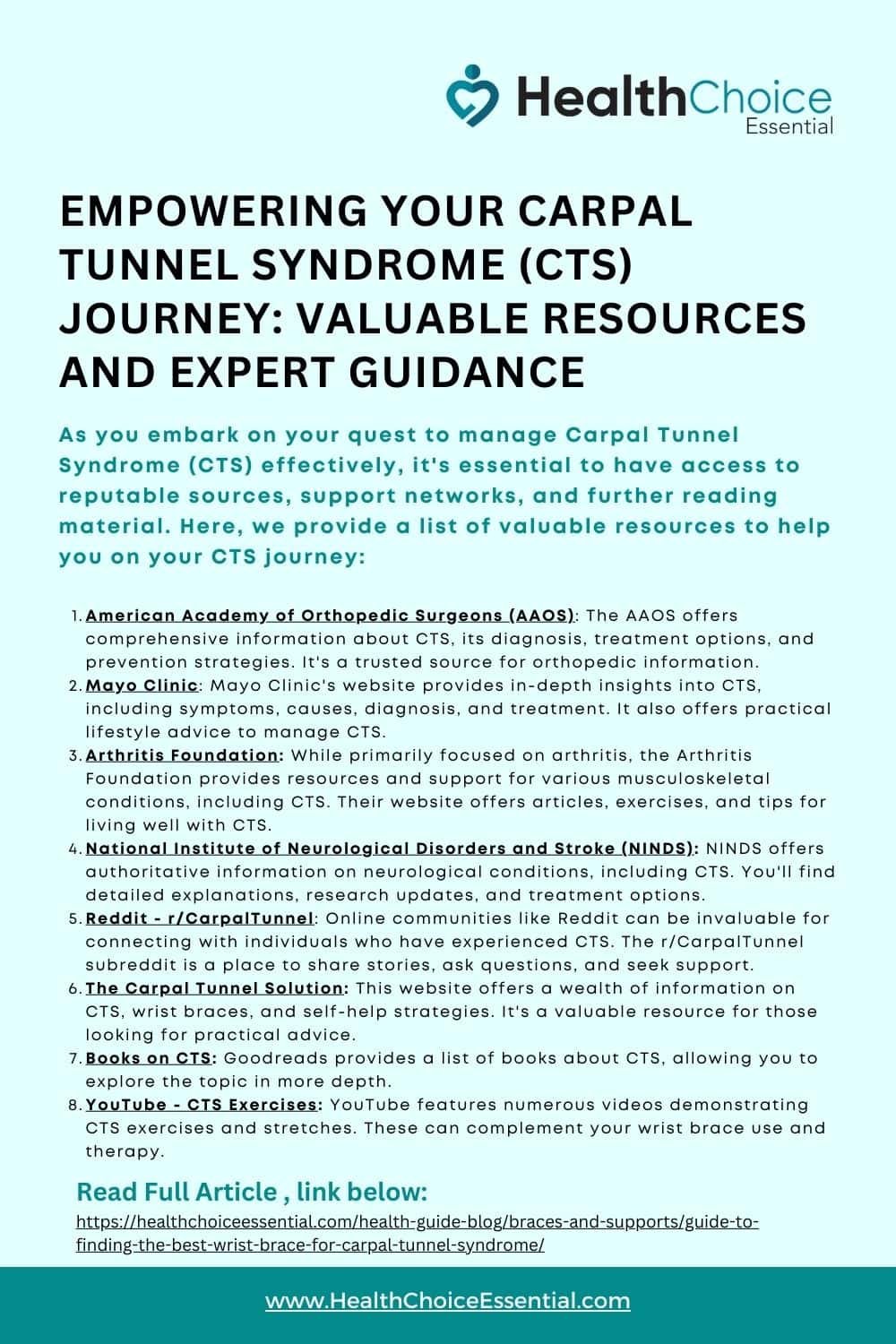
Download Navigating Carpal Tunnel Syndrome (CTS) Essential Information and Supportive Resources
